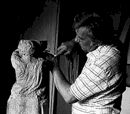When talking of things serious he is sober, quiet and serene - so long as the conversation continues on the lines of a normal exchange of ideas. Then, suddenly, if the talk slides onto the less transparent aspects which, unfortunately, are part of everyday life and of life everywhere, Nino Gorni's true character emerges. Profoundly humane, he is far not only from accepting compromises in human relations, but even from the mere possibility of their existence. He rebels against them, as hotly and as passionately as is the inspiration of his paintings. The essential matter of his art comes from the life he has led.


First, there is his first-hand experience with his work. Second comes the period of time spent in Venice, closely observing the fishermen from Chioggia surrounded by their nets and catch. Then, too, there is his thirst for ever greater knowledge of the people he meets in his regular wanderings from the north to the centre and south of our country. To this essence of his art Gorni dedicates his self with huge, meticulous care, patiently applying his compositional technique from the embryonic to the first stage of each piece of work.At first sight, in front of his paintings one tends to wonder: abstraction, manikins, what's the artist's message to whoever is looking at the canvas?
